My JEM has been through some guitar surgery and, I’m pleased to say, come out stronger for it. The JEM 7VP has the bones of a great guitar, but there are some frustrating corners cut, and some hardware choices that I’m not the biggest fan of. A lot of this is personal preference; I must have spent hours gazing at the JEM page of the Ibanez catalogue in the early nineties, wishing I could afford the original JEM 7V.
The first modification is pretty straightforward, but also a personal choice; I really like the original Edge, which is one of the best vibrato units ever and the preferred choice of both Joe Satriani and Steve Vai….. but the Lo-Pro Edge is just better. It’s more ergonomic, it looks better, and it’s easier to re-string. The original Edge might have a semi-tone more pull-up, depending on how it’s been set up. This is a straight swap – just take out the Edge, drop in the Lo-Pro, and then spend the customary tedious half an hour balancing string/spring tension. I originally also added the Allparts Tremol-no but had to take it back out due to subsequent modifications.
The second is where things get more involved, and more interesting. This was inspired by two factors. The first was that the electronics in the 7VP, particularly the pots, are pretty garbage-tier and really don’t do the fantastic Evolution pickups any justice, so I was already contemplating a swap. The second was that my newly Lo-Pro equipped JEM was starting to resemble Vai’s famous FLO more closely than his even more famous EVO. The other main feature on FLO that sets it apart is a Fernandes electromagnetic sustainer system. Vai is both an inveterate guitar tinkerer and a fan of these sustainers, to the extent that half of his personal Pia guitars seem to have one installed in the form of the more flexible and modern Sustainiac system.
The modern Sustainiac Stealth Pro, also a feature of several of Joe Satriani’s newer signature models, has several major advantages over the alternatives. Unlike ‘real’ amp feedback sustain, it doesn’t require insane volumes to achieve, so it’s much more suitable for home recording / plugin-based setups. Unlike a ‘sustain’ pedal, the Sustainiac lets the sustained note evolve and shift to harmonic overtones in a natural way. Unlike an electroacoustic sustainer, you don’t have to clamp a speaker directly to the guitar and deal with a whole bundle of wires going every which way. Unlike an EBow, probably the closest alternative, you don’t need to grow an extra arm to operate it. And finally, unlike the Fernandes sustainer, the company that makes it hasn’t sadly just gone out of business.
Maniac Music, the company behind the Sustainiac system, offer a “semi-install” option which is pretty much a no-brainer. They’ll wire all of their components up to your specification, test them, and attach everything to a piece of cardboard prior to shipping, saving you a fair amount of tricky wiring/soldering. The standard install includes mini-switches for activating the sustainer function and flipping between emphasising the fundamental note or harmonic overtones. I wanted to make as few permanent modifications to the instrument as possible, and I never, ever, use the tone control on any guitar, so I went with a push-pull on the volume pot and replaced the tone with a custom push-pull pot for mode switching and controlling the intensity of the sustain effect. The semi-install is particularly recommended for recent Ibanez guitars since they use a pickup selector switch which is pretty poor in quality, difficult to wire the sustainiac into, and also too big to allow the Sustainiac’s wiring to be accommodated in the control cavity. Alan at Maniac Music was very helpful and supplied a better quality, compatible pickup selector.
The first thing I did was attach the Sustainiac driver and a couple of spare pickups to a knock-off JEM pickguard I acquired from AliExpress (the people who made it went to the trouble of getting the shape pretty much exactly right, and then drilled all of the screw holes in completely the wrong places for reasons which I am sure made sense at the time). The driver replaces the neck pickup; it actually doubles as an active mini-humbucker and comes in both single coil-sized and humbucker-sized configurations. I soldered everything according to the very comprehensive instructions, and added a barrel jack temporarily cannibalised from another guitar.
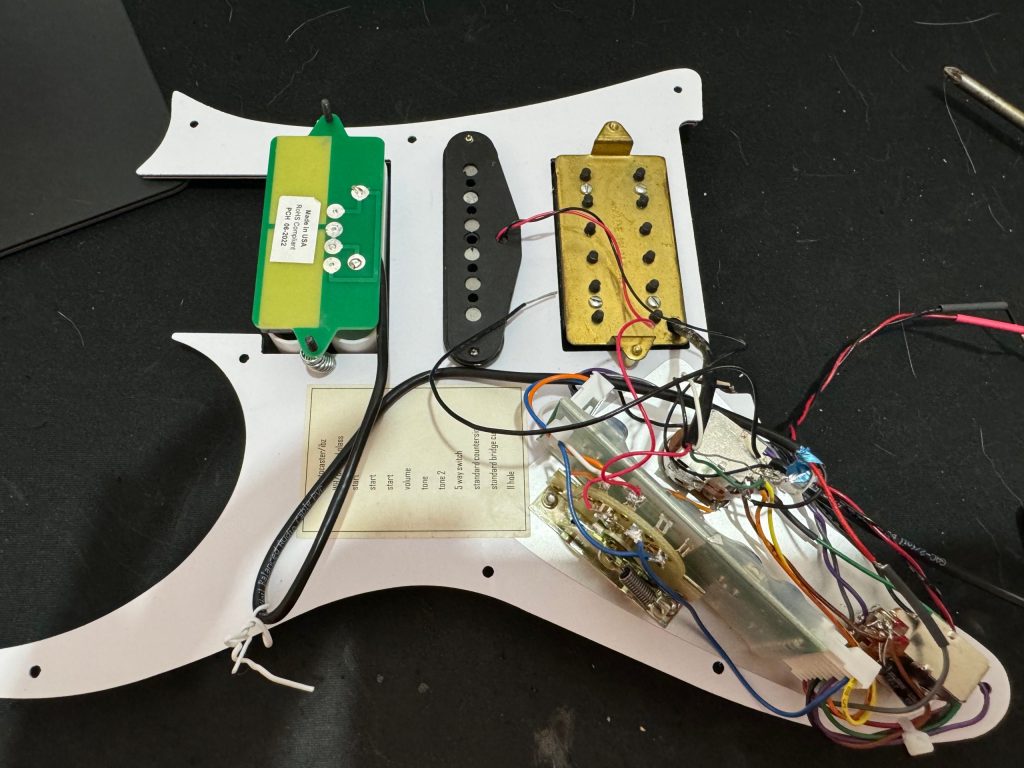
This “breadboard” install can actually be tested without going to the trouble of fitting it into the guitar, by attaching the 9-volt battery, grounding the ground wire (very important) and then holding the whole thing up “backwards” to the strings of another guitar. If everything is working, and you get the position right, the sustainer will start to make the strings vibrate.
The next step is to try to fit the whole thing into the guitar. For a JEM or RG-type Ibanez, this is easier said than done. The first few times I tried, I simply couldn’t get all of the parts into the control cavity at once. One way around this is to remove all of the parts from the pickguard and lay them out into the guitar, first, and then lay the pickguard over the top and finally screw the components into place one by one. This approach also slightly reduces the pain of getting the cable to the output jack and the battery/ground wires through their respective channels into the jack socket and tremolo cavities.
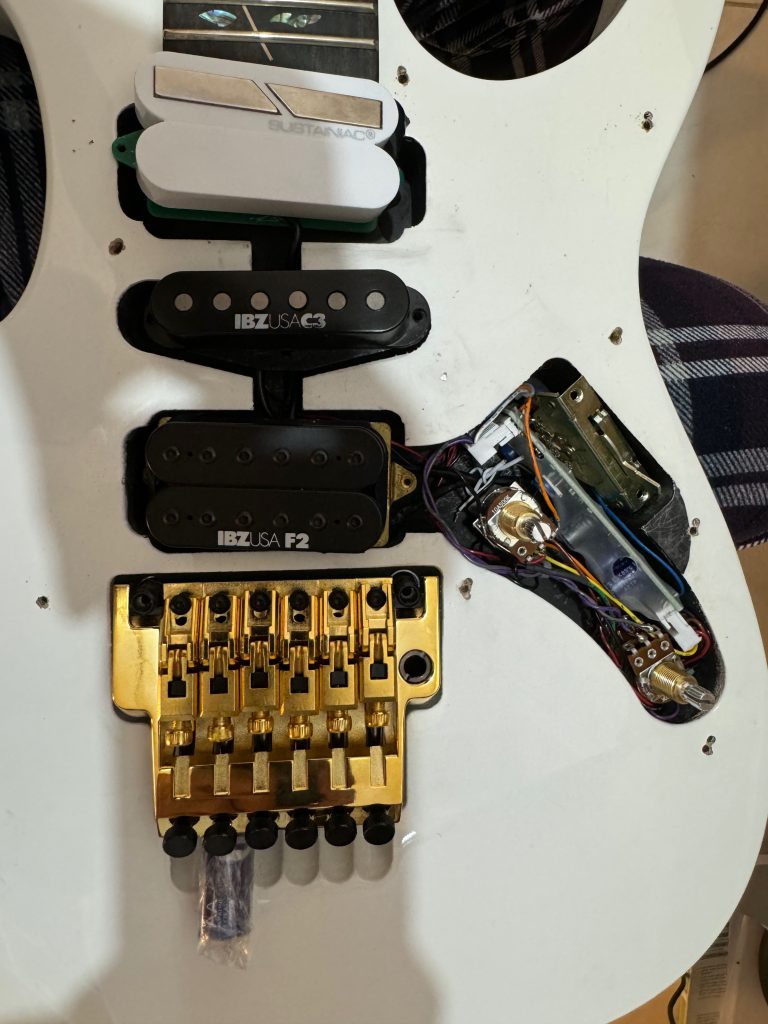
After that, it’s a case of soldering to the output barrel jack, the ground wire and the 9-volt battery terminals and then figuring out what on earth to do with the battery, since I’m too much of a coward to route a hole for a battery compartment in my guitar. Here’s the first, extremely high-tech approach I came up with:
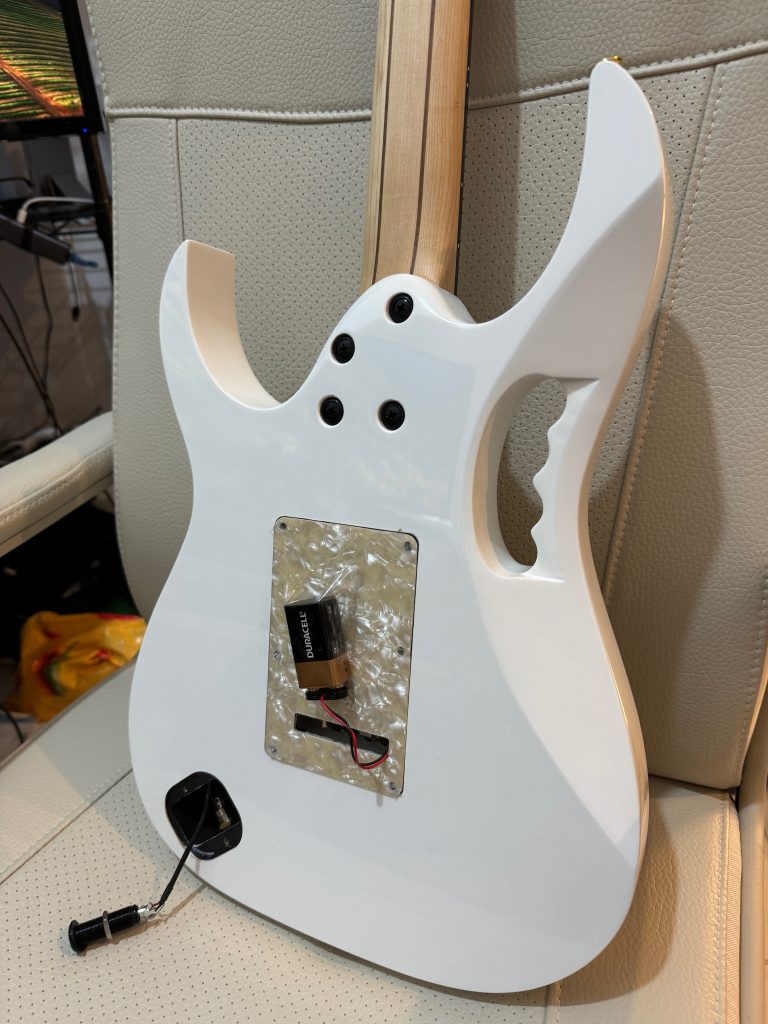
After fiddling around for a bit, I finally found a way to get the battery into the guitar without resorting to sticky tape or routing anything:
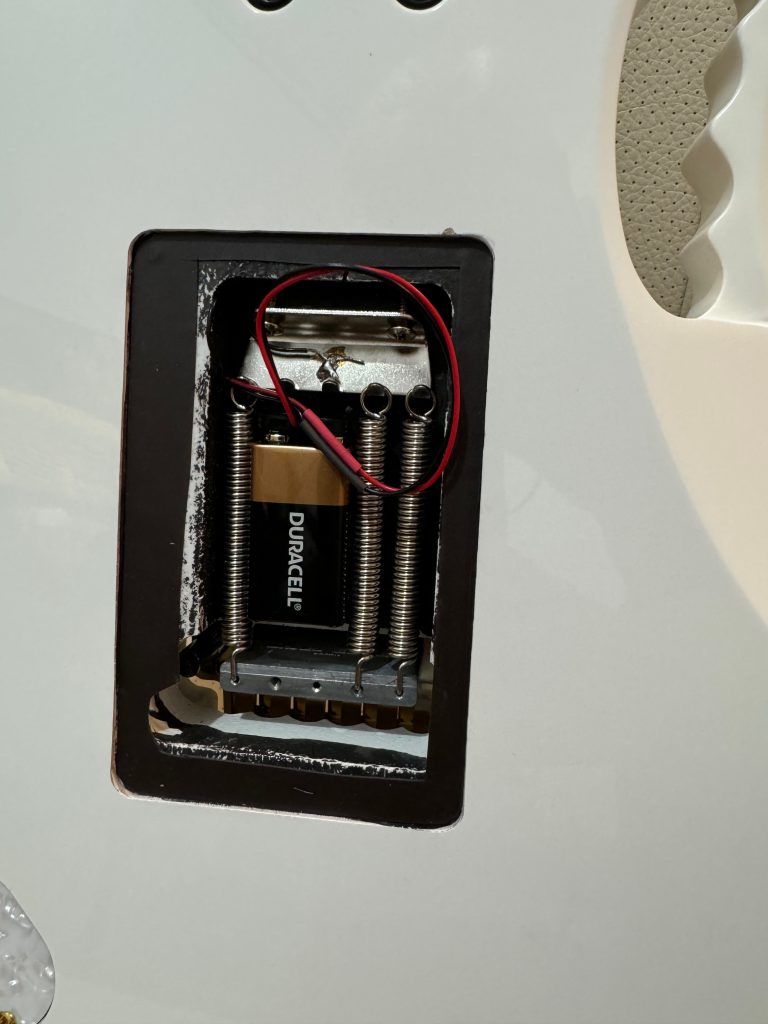
Believe it or not, the tremolo still works just fine and the battery is held comfortably in place by the springs. Note also the final mod: I’m using magnetic sheets to hold the tremolo cavity cover in place for easy access to the battery.
Here’s the final result with everything put back in place, including the original Evolution bridge and middle pickups (right), compared with the guitar in its original state (left):
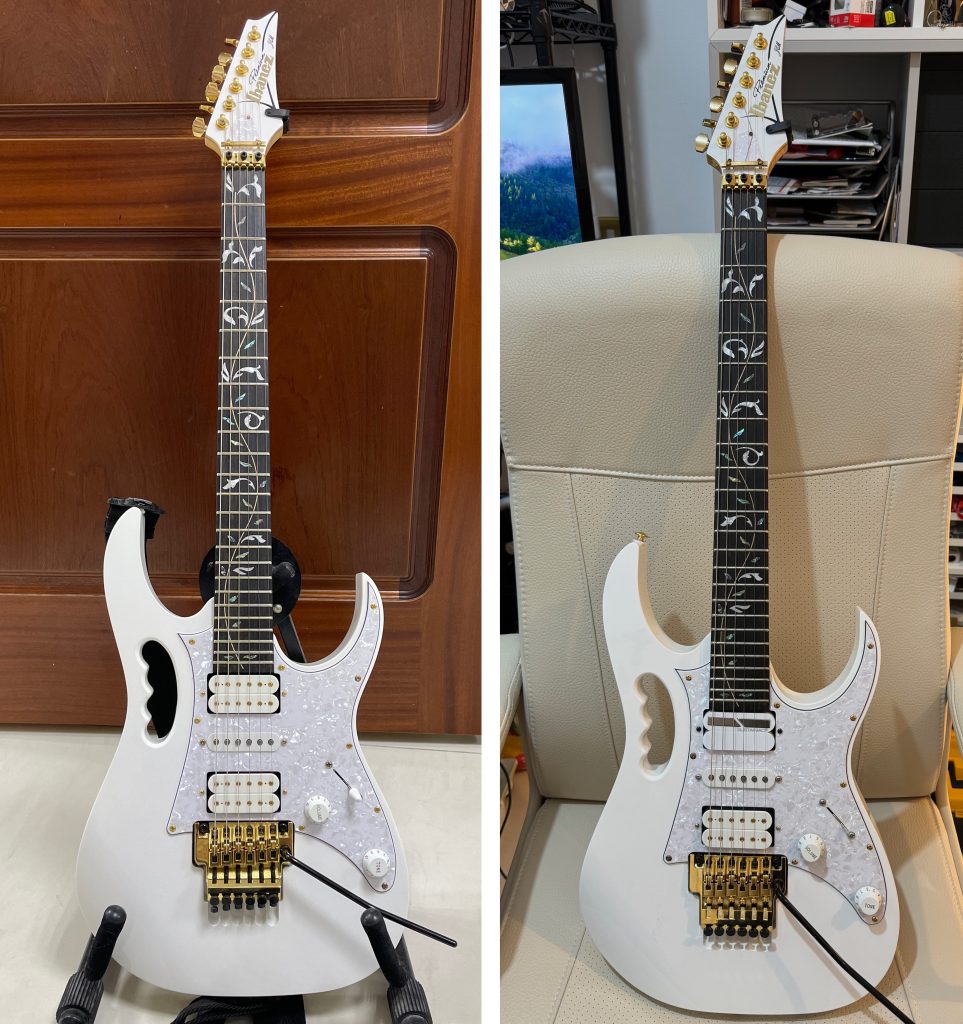
As well as adding a lot of versatility to the instrument, the new wiring makes for a much better, clearer sounding guitar. I’m really looking forward to recording more music with it.
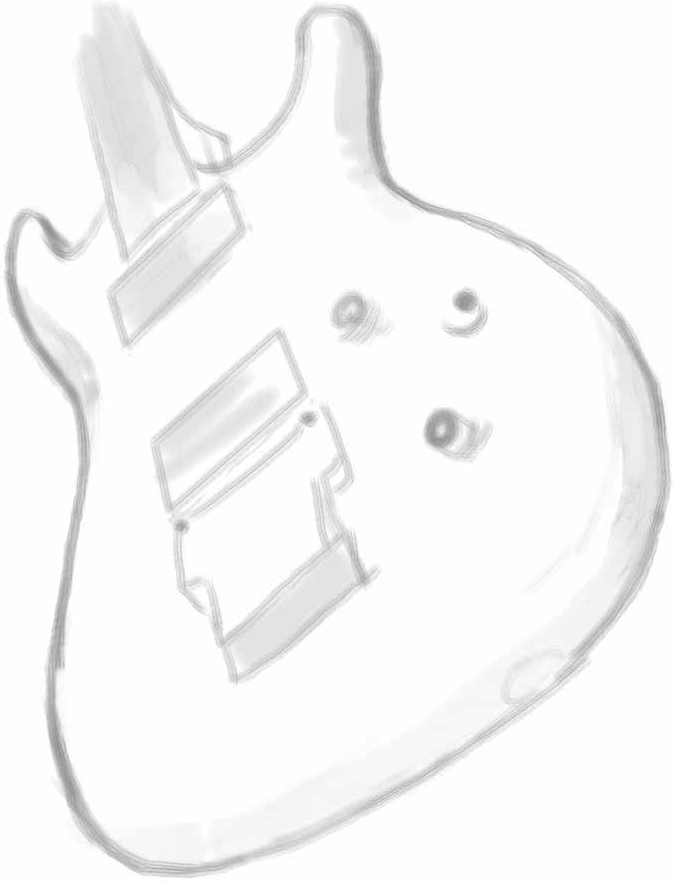
Leave a Reply